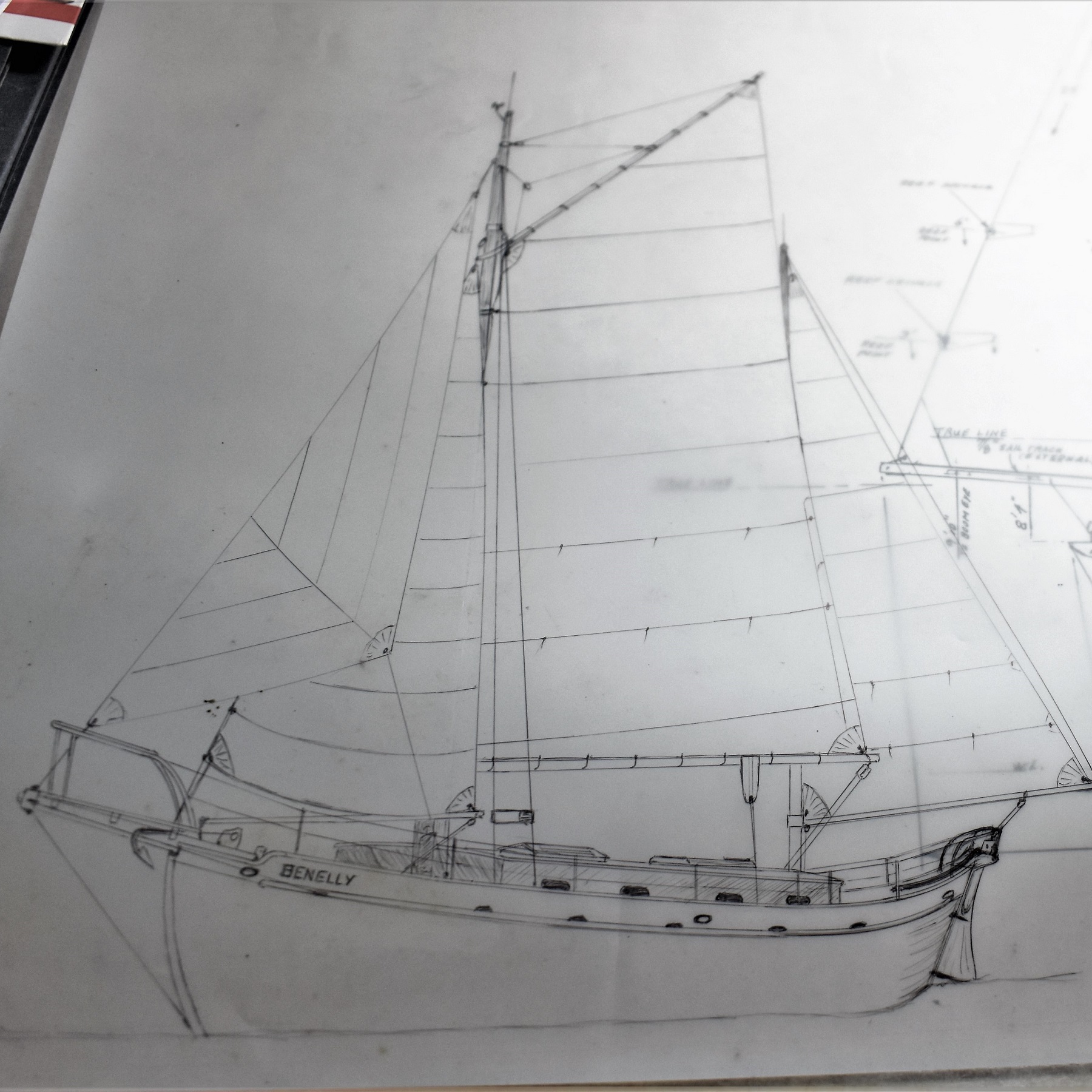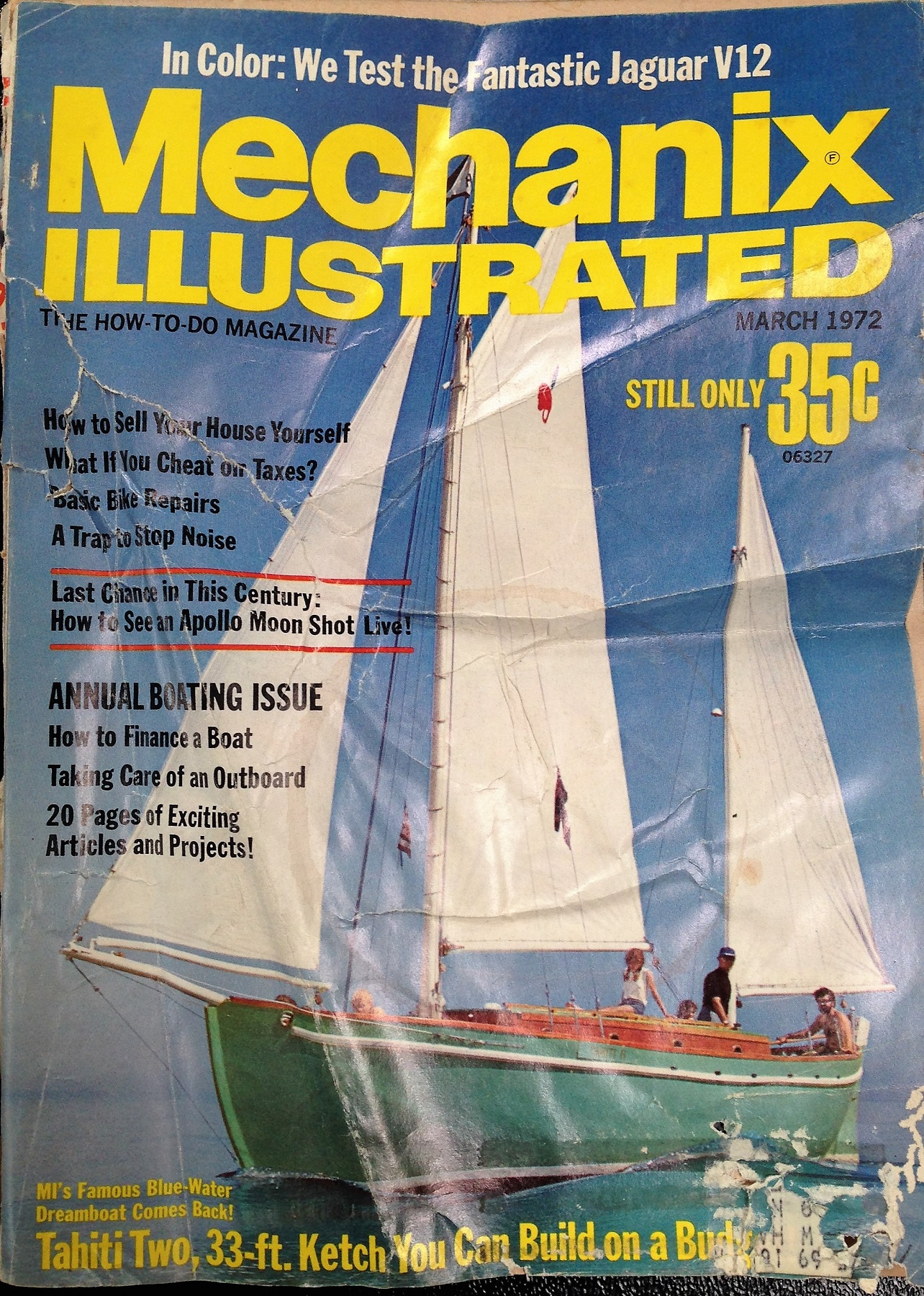

 Drawing by Benjamin Severns as he built his Tahiti Ketch, Benelly.
Drawing by Benjamin Severns as he built his Tahiti Ketch, Benelly.John Hanna designed many yachts throughout his career. Some of these were custom designs for clients, and others were published to the pages of magazines such as Mechanix Illustrated . Many of those published designs were created to be easily built by amateurs, with inexpensive methods and materials, and reliable results.
The most encompassing book about Hanna is John Stephen Doherty’s A Ketch Called Tahiti (1987); the book focuses on the Tahiti Ketch design and many examples of her builds and voyages, but also details John Hanna’s life and other designs. The following short bio is summarized from the pages of A Ketch Called Tahiti :
John Griffin Hanna was born in Galveston, Texas on October 14, 1889. As a youngster he was creative and experimental; he built his own boat from a kit when he was a teen, and then modified the design when it was later damaged. He was an avid reader of The Rudder and Yachting—publications that he would later have a professional relationship with.
As a young man he pursued an interest in aviation, and worked in NY in a small crew building aircraft. A few years later, in 1913, he stayed on his brother’s ranch in Texas for a while as he designed and built his own airplane, and when this venture was not as successful as hoped, he went back to work in the industry a year later to design, layout on wood, and hand carve propellers.
In 1917 he married his wife Dorothy, and settled in Dunedin, Florida. He had moved to Florida in 1916 to purchase the Aburndale News and act as editor and publisher. During this time his writing talents were well-recognized; he was known as an expressive and communicative writer. Some say that his ability and style with writing grew from his deafness, and his choice to communicate predominantly through the written word. In 1903, as a young teen, Hanna had contracted scarlet fever, which destroyed his hearing and left him deaf. (Soon thereafter he suffered a trolley accident when he couldn’t hear the warning bell, and his right foot was severed at the ankle and he thereafter used a prosthetic limb.) While in Florida be began to turn his attention towards designing yachts, but he then sold the newspaper and moved north again during WWI for aviation work.
After the war he returned to Florida, and published his first yacht design Pelican , a thirty-foot ketch in MotorBoat magazine in 1919. He also wrote a regular column for the magazine called, “Heaving the Lead,” and began earning attention in the maritime industry.
According to the research of Stephen Doherty, the evolution of Hanna’s most popular design, the Tahiti Ketch, began in 1921, when Hanna published designs for a lighter, shallower, and narrower thirty-foot double-ended ketch with dual cockpits called Orca . This design may have been inspired by Hanna’s own boats, including a 28-foot cruiser named Beachcomber and a 29-foot fishing boat named American Girl, which he called an “Americanized design […] evolved from the Greek Sponger model” and imagined might be quite comfortable with a large cabin instead of a fish hold. Using these boats and designs for inspiration while continuing to study double-ended vessels from around the world, he began to refine his ideas for a comfortable cruiser and published the results as the thirty-foot double-ended ketch Neptune in 1923.
Some years passed and a number of Neptune designs were built and sailed, and in 1935 Westy Farmer, a friend of Hanna’s and the editor of Modern Mechanix (later Mechanix Illustrated) was beginning production of the magazine’s annual issue “How to Build 20 Boats.” Farmer proposed that the issue should republish the Neptune plans, including a few improvements and some additional construction drawings, photos of the first-build, Carcassonne, and experiences of the five boats already sailing. It was decided that the design should be renamed Tahiti, as inspiration during the Great Depression, and Hanna’s article proclaimed that, “In short, whatever it takes to get to Tahiti and back, this ship has.”
Also included in John Hanna's Tahiti Ketch article with an inspirational illustration of the vessel sailing, was a short poem:
Poke her nose to the mornin' sun,
On a tide that's ebbin' speedy-
Start her sheets to the breeze fresh run
On a slant for old Tahiti
And with that, the Tahiti Ketch was born and marketed as the boat that could cure wanderlust. With inexpensive plans and a simple approach, the type was built in backyards around the world to be sailed near and far.

As a boat popularly built by amateur boat-builders, Tahiti Ketches are found with a variety of modifications and personal touches—and a bit of experimentation. Online searches and sale listings, as well as A Ketch Called Tahiti, show a variety of rigs to increase performance in light winds, differing interiors, as well as changes on deck. A slightly larger-sized production line offered with a variety of rig options, the fiberglass Dreadnaught 32 was inspired by the Tahiti Ketch “Adios,” and dozens were built by Dreadnaught Boatworks in California. In the 1970’s, an article in Mechanix Illustrated (March 1972) featured Glooscap II, built by Gordon Baird of Canada, with an enlarged design and some modern elements and tips, and it is this article that inspired Ben Severns, the builder of our Evelyn, as he was deciding which boat design to build in his backyard:
“According to the article, over the years the Tahiti design was considered the most perfect, stable, all around little deep water sailor ever conceived. Prior to the introduction of fiberglass, many of the original designs had been built by do-it-yourself builders around the world. They had logged many ocean crossings and over a dozen world-circling voyages, including one that had made two circumnavigations.” (Benjamin O. Severns, The Life and Adventures of a Country Lad page 143)
It seems that with this publication a new generation of Tahiti’s were built; my father, then in his twenties, remembers watching one as it was built nearby his home, and enjoyed reading this and a later article in WoodenBoat (Issue 8, 1976) so much that he saved them—in 2016, he found his original copy of Mechanix Illustrated as he was cleaning my grandmother’s attic.
A KETCH CALLED TAHITI • By John Stephen Doherty (1987)
Find it on Amazon.
MECHANIX ILLUSTRATED • Article by Gordon Baird (March 1972)
Find magazine back issues here.
GLOOSCAP II • Information about Glooscap II posted by the current owner.
Go to the website.
WOODENBOAT • Cover article is about the Tahiti Ketch Josepha: Issue #8 (Jan/Feb 1976)
Go to the WoodenBoat Store's Digital Issue Library.
THE LIFE AND ADVENTURES OF A COUNTRY LAD • By Benjamin O. Severns (2015)
Find it on Amazon.